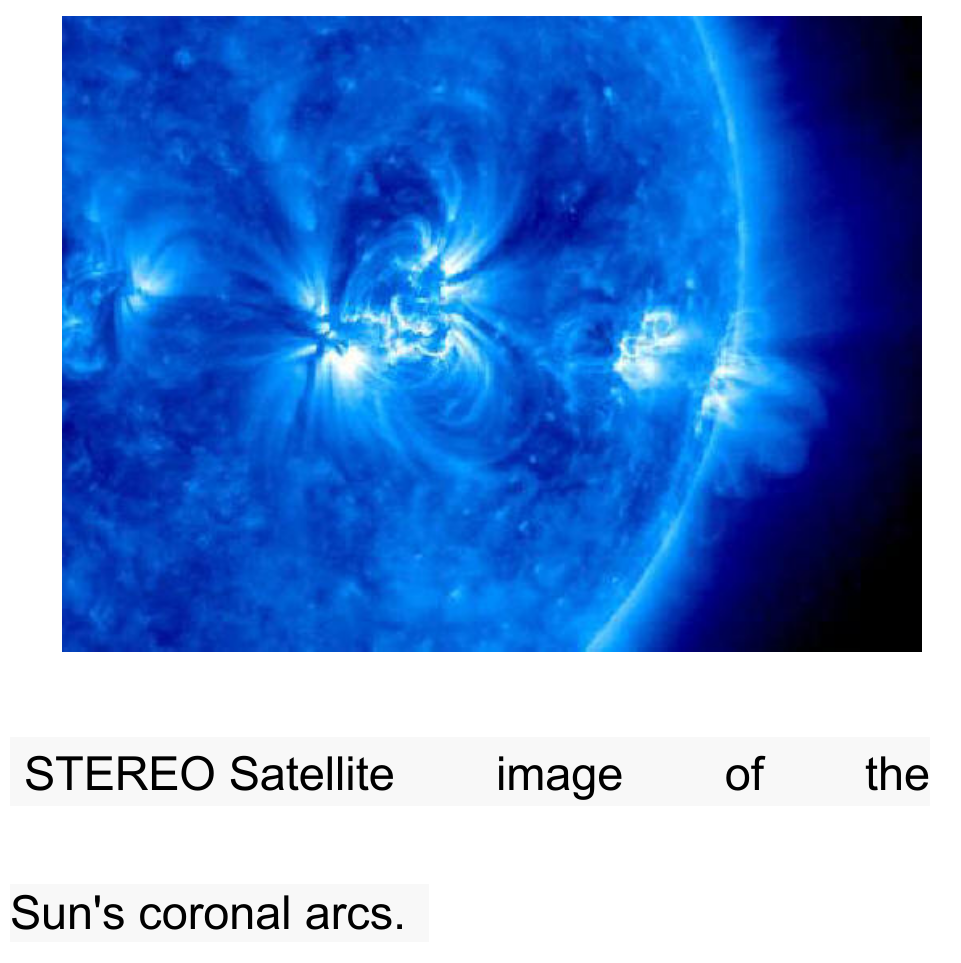ザ・サンダーボルツ勝手連 [Adhering to Fusion フュージョンに固執する]
[Adhering to Fusion フュージョンに固執する]

太陽のコロナアーク(冠状弧)のSTEREO人工衛星画像。
―――――――
Jul 07, 2009
コアの深部からの熱核融合反応が太陽を駆り立てると言われています。 ほとんどの太陽物理学者が「他に何ができるだろうか?」と言うのは非常にありふれた仮定になっています。
「多くの批評家がこれらの恒星達が十分に熱くないと考えていることを私は知っています。
批評家たちは明白な反論に自分自身を晒して居ます;
私達は、もっと暖かい場所を探しに行って見つけるように彼らに言います。」
ーアーサー・エディントン
分光分析によると、太陽は主に水素ガス(71%)で構成され、27%がヘリウムで、残りは酸素、窒素、硫黄、炭素、およびその他の6つの元素のわずかな割合であると考えられています。
地球上のすべての元素は太陽のスペクトログラムで見ることができますが、これらの12(元素)はその質量の99.9%を占めています。
太陽の直径は139万キログラムで、質量は約1.98 X 10 ^ 30キログラムです。
その表面で測定された温度は5800ケルビンであり、コアでは15,600,000ケルビンと推定されています。
従来のモデルが示唆しているように、太陽は外向きの放射圧を生成する必要があります、そうしないと、重力によって太陽が圧縮されて比較的小さな固体の球体になります。
理論によれば、エネルギー源は太陽の内部に存在し、重力収縮に対抗する力として機能する必要があります。
アーサー・エディントン卿の古典的な作品「恒星の内部構成」では、核融合だけが、太陽が「自重で」崩縮するのを防ぎ、何十億年も続くのに十分な放射エネルギーを生み出すことができるということです。
〈https://books.google.com/books/about/The_Internal_Constitution_of_the_Stars.html?id=RjC9DpnWFbkC#v=onepage&q=The%20Internal%20Constitution%20of%20the%20Stars&f=false〉
科学者がこれらの核融合反応を説明するプロセスは、エディントンの理論から数年後まで数学的にモデル化されていなかったため、それは、実験的研究の結果というよりも、当時の信仰の表明でした。
〈http://www.sns.ias.edu/~jnb/SNviewgraphs/NuclearFusion/nucfusion.html〉
仮に、太陽はどのようにして、平均距離149,476,000キロメートルで私たちの惑星の生命を維持するのに十分な熱と光を生み出すのでしょうか?
太陽がその保育園であったと思われる星雲から凝縮したとき、ガスはそれらが1000万ケルビンより高い温度に達するまで重力によって圧縮されました。
その温度で、水素原子は個々の陽子と電子に分解され、陽子は互いに自由に衝突します。
陽子-陽子(p-p)鎖と呼ばれる反応の最初のステップは、これらの最初の陽子衝突であると言われています。
〈http://hyperphysics.phy-astr.gsu.edu/hbase/Astro/procyc.html〉
陽子がこれらの高温で衝突すると、陽子は他の粒子に融合するのに十分な速さで移動します:
重水素、陽電子、ニュートリノ。
重水素は陽子と中性子の組み合わせであり、陽電子は正に帯電した電子です。
ニュートリノは、電荷を持たず、ほとんど質量がないことを除けば、電子に似ています。
中性であるため、電子に影響を与える電磁力の影響を受けません。
p-p反応の第2段階は、重水素が別の陽子を捕獲すると同時にガンマ線を放出するときにヘリウム3核が形成されることです。
ヘリウム4核と2つのニュートリノが反応の最終結果ですが、多くの異なる反応経路の1つをたどることができます。
実際には、電気的宇宙理論家のウォル・ソーンヒルが指摘しているように、恒星達はおそらく1光日と同じくらいの大きさのプラズマシース内に存在します。
〈https://www.holoscience.com/wp/solar-neutrino-puzzle-is-solved/〉
それらは、恒星達の電気的影響と銀河を流れる電流との間の境界です。
〈electrical influence〉
ウォルはこの様に書いた:
「太陽のプラズマシース、つまり「太陽圏」は、地球が太陽から離れている場合よりも約100倍離れています。
太陽圏の広大さを知ると、天の川のすべての恒星達は冥王星の軌道に囲まれた球の中に収まる可能性があります。
太陽の太陽圏は、8つの天の川からの恒星達を収容することができます!
その比較的冷たい光球の振る舞いから、太陽が銀河放電における陽極、または正に帯電した電極であることは明らかです。
赤い彩層は、放電管の陽極表面の上の輝きに対応しています。
電流密度が高すぎてアノード表面に対応できない場合、明るい二次プラズマが一次プラズマ内に形成されます。
これは「アノード・タフティング」と呼ばれます。
太陽の上では、タフト(房)はしっかりと詰め込まれているため、上部は「造粒」のように見えます。」
恒星達は、内側ではなく、外側からそれらの力を受け取ります。
核反応は太陽の核ではなく、太陽の表面で起こっています。
太陽風は、太陽とその惑星の家族およびその銀河系を接続する電流であるため、太陽炉が放射する90年前の理論を再検討する必要があります。
By Stephen Smith
スティーブン・スミス著
―――――――
Jul 07, 2009
Thermonuclear fusion reactions from deep in the core are said to drive the Sun. It has become so commonplace an assumption that most solar physicists say, "What else could it be?"
コアの深部からの熱核融合反応が太陽を駆り立てると言われています。 ほとんどの太陽物理学者が「他に何ができるだろうか?」と言うのは非常にありふれた仮定になっています。
"I am aware that many critics consider the stars are not hot enough.
「多くの批評家がこれらの恒星達が十分に熱くないと考えていることを私は知っています。
The critics lay themselves open to an obvious retort;
we tell them to go and find a hotter place."
ー Arthur Eddington
批評家たちは明白な反論に自分自身を晒して居ます;
私達は、もっと熱い場所を探しに行って見つけるように彼らに言います。」
ーアーサー・エディントン
According to spectrographic analysis, the Sun is composed primarily of hydrogen gas (71%), with 27% helium and the remainder thought to be minute percentages of oxygen, nitrogen, sulfur, carbon, and six other elements.
分光分析によると、太陽は主に水素ガス(71%)で構成され、27%がヘリウムで、残りは酸素、窒素、硫黄、炭素、およびその他の6つの元素のわずかな割合であると考えられています。
Although every element on Earth can be seen in a spectrogram of the Sun, those 12 make up 99.9% of its mass.
地球上のすべての元素は太陽のスペクトログラムで見ることができますが、これらの12(元素)はその質量の99.9%を占めています。
The Sun is 1,390,000 kilometers in diameter, with a mass approximation of 1.98 X 10^30 kilograms.
太陽の直径は139万キログラムで、質量は約1.98 X 10 ^ 30キログラムです。
The temperature measured at its surface is 5800 Kelvin and is estimated to be as high as 15,600,000 Kelvin in the core.
その表面で測定された温度は5800ケルビンであり、コアでは15,600,000ケルビンと推定されています。
As conventional models suggest, the Sun must generate outward radiation pressure or gravity would compress it into a relatively tiny, solid ball.
従来のモデルが示唆しているように、太陽は外向きの放射圧を生成する必要があります、そうしないと、重力によって太陽が圧縮されて比較的小さな固体の球体になります。
The theory states that an energy source must exist inside the Sun, acting as a counter force to gravitational contraction.
理論によれば、エネルギー源は太陽の内部に存在し、重力収縮に対抗する力として機能する必要があります。
It seemed to Sir Arthur Eddington in his classic work, The Internal Constitution of the Stars, that only nuclear fusion could produce radiative energy sufficient to prevent the Sun from collapsing "under its own weight" and last for billions of years.
アーサー・エディントン卿の古典的な作品「恒星の内部構成」では、核融合だけが、太陽が「自重で」崩縮するのを防ぎ、何十億年も続くのに十分な放射エネルギーを生み出すことができるということです。
〈https://books.google.com/books/about/The_Internal_Constitution_of_the_Stars.html?id=RjC9DpnWFbkC#v=onepage&q=The%20Internal%20Constitution%20of%20the%20Stars&f=false〉
Since the processes by which scientists describe those fusion reactions were not mathematically modeled until years after Eddington's theory, it was more a statement of faith at the time than it was a result of experimental research.
科学者がこれらの核融合反応を説明するプロセスは、エディントンの理論から数年後まで数学的にモデル化されていなかったため、それは、実験的研究の結果というよりも、当時の信仰の表明でした。
〈http://www.sns.ias.edu/~jnb/SNviewgraphs/NuclearFusion/nucfusion.html〉
Hypothetically, how does the Sun produce heat and light enough to sustain life on our planet at a mean distance of 149,476,000 kilometers?
仮に、太陽はどのようにして、平均距離149,476,000キロメートルで私たちの惑星の生命を維持するのに十分な熱と光を生み出すのでしょうか?
When the Sun condensed out of the nebular cloud that is supposed to have been its nursery, the gases were compressed by gravity until they reached temperatures greater than ten-million Kelvin.
太陽がその保育園であったと思われる星雲から凝縮したとき、ガスはそれらが1000万ケルビンより高い温度に達するまで重力によって圧縮されました。
At that temperature, hydrogen atoms are disrupted into individual protons and electrons, leaving the protons free to collide with one another.
その温度で、水素原子は個々の陽子と電子に分解され、陽子は互いに自由に衝突します。
It is these initial proton collisions, it is said, that are the first step in a reaction called the proton-proton (p-p) chain.
陽子-陽子(p-p)鎖と呼ばれる反応の最初のステップは、これらの最初の陽子衝突であると言われています。
〈http://hyperphysics.phy-astr.gsu.edu/hbase/Astro/procyc.html〉
When protons collide at those high temperatures, they are moving fast enough to fuse into other particles:
deuterium, a positron and a neutrino.
陽子がこれらの高温で衝突すると、陽子は他の粒子に融合するのに十分な速さで移動します:
重水素、陽電子、ニュートリノ。
Deuterium is a proton-neutron combination, while a positron is a positively charged electron.
重水素は陽子と中性子の組み合わせであり、陽電子は正に帯電した電子です。
Neutrinos are similar to electrons, except they do not carry an electric charge, and are almost massless.
ニュートリノは、電荷を持たず、ほとんど質量がないことを除けば、電子に似ています。
Being neutral, they are not affected by the electromagnetic forces that affect electrons.
中性であるため、電子に影響を与える電磁力の影響を受けません。
The second stage in the p-p reaction is the formation of a helium-3 nucleus when the deuterium captures another proton, while at the same time emitting a gamma ray.
p-p反応の第2段階は、重水素が別の陽子を捕獲すると同時にガンマ線を放出するときにヘリウム3核が形成されることです。
A helium-4 nucleus and two neutrinos are the end results of the reaction, although it can follow one of many different reaction paths.
ヘリウム4核と2つのニュートリノが反応の最終結果ですが、多くの異なる反応経路の1つをたどることができます。
In reality, as Electric Universe theorist Wal Thornhill points out, stars reside within plasma sheaths perhaps as great as a light-day in extent.
実際には、電気的宇宙理論家のウォル・ソーンヒルが指摘しているように、恒星達はおそらく1光日と同じくらいの大きさのプラズマシース内に存在します。
〈https://www.holoscience.com/wp/solar-neutrino-puzzle-is-solved/〉
They are the borders between the electrical influence of the stars and the currents flowing through the galaxy.
それらは、恒星達の電気的影響と銀河を流れる電流との間の境界です。
〈electrical influence〉
As Wal wrote:
"The Sun’s plasma sheath, or 'heliosphere' is about 100 times more distant than the Earth is from the Sun.
ウォルはこの様に書いた:
「太陽のプラズマシース、つまり「太陽圏」は、地球が太陽から離れている場合よりも約100倍離れています。
To give an idea of the immensity of the heliosphere, all of the stars in the Milky Way could fit inside a sphere encompassed by the orbit of Pluto.
太陽圏の広大さを知ると、天の川のすべての恒星達は冥王星の軌道に囲まれた球の中に収まる可能性があります。
The Sun’s heliosphere could accommodate the stars from 8 Milky Ways!
太陽の太陽圏は、8つの天の川からの恒星達を収容することができます!
It is clear from the behavior of its relatively cool photosphere that the Sun is an anode, or positively charged electrode, in a galactic discharge.
その比較的冷たい光球の振る舞いから、太陽が銀河放電における陽極、または正に帯電した電極であることは明らかです。
The red chromosphere is the counterpart to the glow above the anode surface in a discharge tube.
赤い彩層は、放電管の陽極表面の上の輝きに対応しています。
When the current density is too high for the anode surface to accommodate, a bright secondary plasma forms within the primary plasma.
電流密度が高すぎてアノード表面に対応できない場合、明るい二次プラズマが一次プラズマ内に形成されます。
It is termed 'anode tufting.'
これは「アノード・タフティング」と呼ばれます。
On the Sun, the tufts are packed together tightly so that their tops give the appearance of 'granulation.'”
太陽の上では、タフト(房)はしっかりと詰め込まれているため、上部は「造粒」のように見えます。」
The stars receive their power from outside, not inside.
恒星達は、内側ではなく、外側からそれらの力を受け取ります。
Any nuclear reactions are taking place on the surface of the Sun and not in its core.
核反応は太陽の核ではなく、太陽の表面で起こっています。
The solar wind is an electric current connecting the Sun with its family of planets and with its galactic clan, so the 90-year-old theory of fusion firing the solar furnace needs to be reexamined.
太陽風は、太陽とその惑星の家族およびその銀河系を接続する電流であるため、太陽炉が放射する90年前の理論を再検討する必要があります。
By Stephen Smith
スティーブン・スミス著